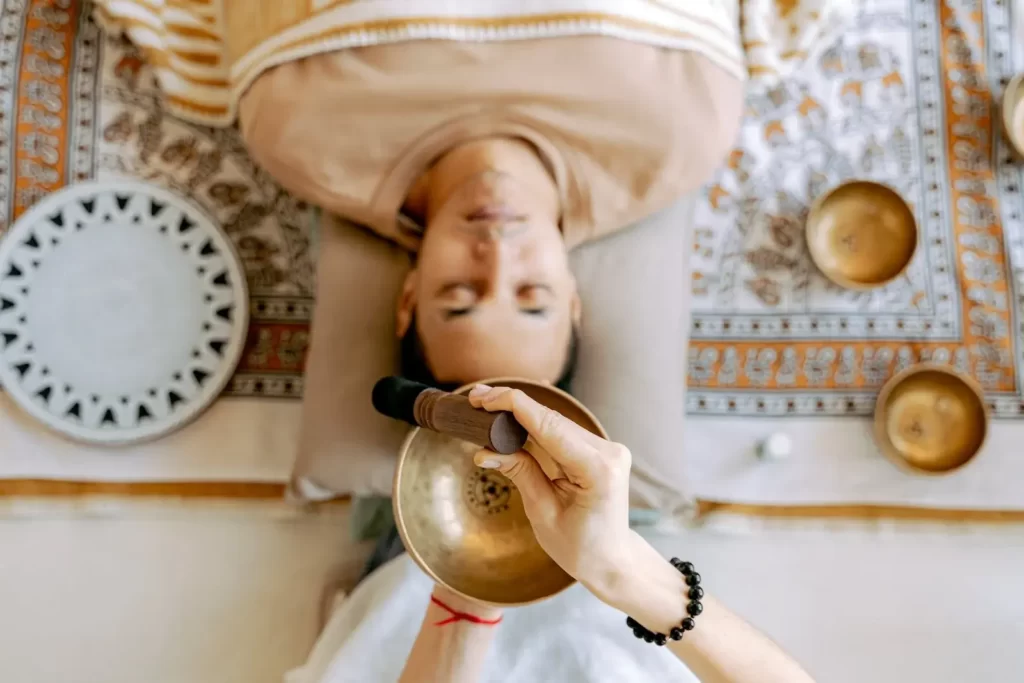Since ancient times, people have employed the straightforward and powerful technique of cross-legged meditation to promote relaxation, lessen tension, and enhance general well-being. One assumes a relaxed reclining position with legs crossed and hands resting on knees or thighs.
Numerous advantages of sitting cross-legged while meditation might improve one’s physical and mental well-being. Reduced blood pressure, better digestion, and greater immunity are a few physical advantages. In terms of the mind, cross-legged meditation can help lower tension and anxiety, boost concentration and focus, and elevate mood.

Many meditators have also found that sitting cross-legged enhances their sense of calm and connection to the divine.
Use the right technique and posture when doing cross-legged meditation to gain maximum benefits. This entails settling into a comfortable seated position, paying attention to the breath, keeping an open mind, and, if chosen, using a mantra or imagery. It’s crucial to establish a regular practice, look for a calm environment, and make intentions prior to each session.
Cross-legged meditation helps beginners and experts attain physical, mental, and spiritual well-being.
You can feel the benefits of this old age discipline and increase your quality of life with routine practice and commitment.
Benefits of Cross-Legged Meditation.
Since ancient times, people have employed the straightforward yet effective technique of cross-legged meditation to encourage relaxation and enhance general well-being. This kind of meditation has various advantages, including emotional, mental, and physical advantages.
Stress reduction is one of the main advantages of cross-legged meditation. The stress hormone cortisol can be reduced with regular practice, which can help you feel more at ease and relaxed. Additionally, it may result in better sleep and a lessening of depressive and anxious symptoms.

Cross-legged meditation has been demonstrated to have positive impacts on physical health in addition to its benefits for lowering stress. It can enhance digestion, lessen inflammation, and lower blood pressure. Additionally, it might strengthen the immune system, improving general health and well-being.
Cross-legged meditation can boost emotions of happiness and contentment while also helping to focus and concentrate mentally and emotionally. Additionally, it can aid people in gaining a clearer perspective, which enhances their capacity for decision-making and problem-solving.
Techniques for Cross-Legged Meditation
It is a technique that entails sitting comfortably with the legs crossed and concentrating the mind on the current moment. Even though it can appear easy, there are a number of techniques that can be used to maximize one’s meditation practice.
Finding a comfortable seating position is a key approach. For back support and a cozy base for the legs, this may include utilizing a cushion or a chair. It’s crucial to settle into a posture that you can maintain for the duration of your meditation practice.

Concentrating on the breath is another important strategy. This entails using the sensation of the breath as it enters and exits the body as an anchor to help you stay present and focused.
Another crucial aspect of cross-legged meditation is the practice of impartial thought observation. This entails recognizing thoughts as they occur without being sucked into them or giving them context. People may benefit from having a clearer perspective, which will help them make better decisions and solve problems.
In addition to these methods, people might use mantras or visualizations to hone their concentration and advance their meditation practices. People can feel more at ease, relaxed, and well-being overall by adopting these methods into their meditation practice.
Tips for Cross-Legged Meditation.
Cross-legged meditation has been shown to be an effective method for enhancing one’s physical, mental, and emotional health. Although the technique itself is quite straightforward, there are several suggestions that can help people make the most of their meditation practice.
Setting intentions before starting the meditation practice is a key piece of advice. This entails pausing for a moment to consider the motivations for practising meditation and the benefits that one expects to derive from it. It can aid in establishing a sense of direction and purpose and boost motivation to carry on with the exercise.

It’s also crucial to establish a routine. This entails choosing a regular meditation time and location and making a commitment to the practice. Starting with a brief practice, like 5 or 10 minutes, and progressively extending it over time might be beneficial.
When you meditate, it can be helpful to find a place that is quiet and comfortable to sit in. This can involve designating a room or space in the house as a meditation location, or it can just involve locating a quiet area in which to meditate.
It is essential to begin meditation with an attitude of openness and inquiry. People could participate in the activity with the mindset that they are open to discovering new things and expanding their knowledge rather than expecting a specific outcome. This has the potential to foster mindfulness and self-awareness, both of which will improve overall well-being. Those who meditate sitting cross-legged may find that adopting these tips helps them feel more at ease, relaxed, and generally well-balanced.
Conclusion
In conclusion, cross-legged meditation is an effective technique that can enhance mental, emotional, and physical health. People can lessen tension, enhance focus, and create a deeper feeling of mindfulness and self-awareness by sitting comfortably with their legs crossed and focusing their minds on the present moment.
Through consistent practice, people can benefit from a variety of things, such as fewer symptoms of anxiety and sadness, better sleep, lower blood pressure, and greater immunity. People can develop their meditation practice and gain even more advantages by combining strategies like breathing in and out, paying attention to ideas without judgment, and employing mantras or images.
It is crucial to approach cross-legged meditation with an attitude of openness and curiosity, set aims, and develop a consistent practice if you want to obtain the maximum benefit from it. It can be beneficial to locate a calm and relaxing area for meditation.
In conclusion, cross-legged meditation is a straightforward yet effective technique for enhancing general well-being. You can feel calmer, more relaxed, and more general well-being by including this exercise in your daily routine and adopting these suggestions and methods.




Pingback: 10 Healthy Habits That Will Change Your Life